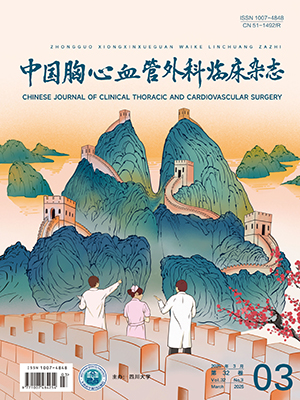| 1. |
Stheneur C, Laffond C, Rioux S, et al. Recent progress in Marfan syndrome. Arch Pediatr, 2012, 19(5): 551-555.
|
| 2. |
Bentall H, De Bono A. A technique for complete replacement of the ascending aorta. Thorax, 1968, 23(4): 338-339.
|
| 3. |
Coselli JS, LeMaire SA, Preventza O, et al. Outcomes of 3309 thoracoabdominal aortic aneurysm repairs. J Thorac Cardiovasc Surg, 2016, 151(5): 1323-1337.
|
| 4. |
宫汉东, 汪曾炜, 张仁福, 等. 升主动脉瘤台并主动脉瓣关闭不全的外科治疗. 中华心胸血管外科杂志, 2001, 17(3): 13.
|
| 5. |
Finkbohner R, Johnston D, Crawford ES, et al. Marfan syndrome. Long-term survival and complications after aortic aneurysm repair. Circulation, 1995, 91(3): 728-733.
|
| 6. |
Ince H, Rehders TC, Petzsch M, et al. Stent-grafts in patients with Marfan syndrome. J Endovasc Ther, 2005, 12(1): 82-88.
|
| 7. |
Nordon IM, Hinchliffe RJ, Holt PJ, et al. Endovascular management of chronic aortic dissection in patients with Marfan syndrome. J Vasc Surg, 2009, 50(5): 987-991.
|
| 8. |
Dong ZH, Fu WG, Wang YQ, et a1. Retrograde type A aortic dissection after endovascular stent graft placement for treatment of type B dissection. Circulation, 2009, 119(5): 735-741.
|
| 9. |
Waterman AL, Feezor RJ, Lee WA, et al. Endovascular treatment of acute and chronic aortic pathology in patients with Marfan syndrome. J Vasc Surg, 2012, 55(5): 1234-1240.
|
| 10. |
Eid-Lidt G, Gaspar J, Meléndez-Ramírez G, et al. Endovascular treatment of type B dissection in patients with Marfan syndrome: mid-term outcomes and aortic remodeling. Catheter Cardiovasc Interv, 2013, 82(7): E898-E905.
|
| 11. |
Cooper DG, Walsh SR, Sadat U, et al. Treating the thoracic aorta in Marfan syndrome: surgery or TEVAR? J Endovasc Ther, 2009, 16(1): 60-70.
|
| 12. |
赵纪春, 黄斌, 袁丁, 等. 外科联合腔内杂交手术治疗马凡综合征所致复杂胸腹主动脉夹层动脉瘤一例. 中华普通外科杂志, 2014, 29(6): 483-484.
|
| 13. |
唐骁, 符伟国, 郭大乔, 等. 马凡氏综合征心血管病变的外科分期治疗 1 例报道. 临床急诊杂志, 2013, 14(3): 108-110.
|
| 14. |
Lipscomb KJ, Smith JC, Clarke B, et al. Outcome of pregnancy in women with Marfan's syndrome. Br J Obstet Gynaecol, 1997, 104(2): 201-206.
|
| 15. |
Eilen B, Kaiser IH, Becker RM, et al. Aortic valve replacement in the third trimester of pregnancy: case report and review of the literature. Obstet Gynecol, 1981, 57(1): 119-121.
|
| 16. |
舒畅, 方坤, 黎明, 等. 晚期妊娠和产褥期主动脉夹层的腔内修复治疗. 中国普通外科杂志, 2013, 22(12): 1541-1547.
|
| 17. |
杨璞玉, 张军, 李燕娜, 等. 合并主动脉夹层的马凡综合征孕妇的妊娠结局分析. 中华妇产科杂志, 2015, 50(5): 334-340.
|
| 18. |
Grabenwöger M, Alfonso F, Bachet J, et al. Thoracic endovascular aortic repair (TEVAR) for the treatment of aortic diseases: a position statement from the European Association for Cardio-Thoracic Surgery (EACTS) and the European Society of Cardiology (ESC), in collaboration with the European Association of Percutaneous Cardiovascular Interventions (EAPCI). Eur J Cardiothorac Surg, 2012, 42(1): 17-24.
|
| 19. |
Preventza O, Price MD, Amarasekara HS, et al. Chronic type Ⅰ and type Ⅲ aortic dissections: a propensity analysis of outcomes after open distal repair. Eur J Cardiothorac Surg, 2018, 54(3): 510-516.
|
| 20. |
Kalkat MS, Rahman I, Kotidis K, et al. Presentation and outcome of Marfan's syndrome patients with dissection and thoraco-abdominal aortic aneurysm. Eur J Cardiothorac Surg, 2007, 32(2): 250-254.
|
| 21. |
LeMaire SA, Carter SA, Volguina IV, et al. Spectrum of aortic operations in 300 patients with confirmed or suspected Marfan syndrome. Ann Thorac Surg, 2006, 81(6): 2063-2078.
|
| 22. |
张良, 于存涛, 常谦, 等. 常温非体外循环胸腹主动脉置换术治疗广泛主动脉瘤. 中华外科杂志, 2016, 54(2): 119-124.
|
| 23. |
孙立忠, 程力剑, 朱俊明, 等. 常温非体外循环下全胸腹主动脉替换术. 中华胸心血管外科杂志, 2011, 27(12): 705-708.
|
| 24. |
Juthier F, Rousse N, Banfi C, et al. Endovascular exclusion of patch aneurysms of intercostal arteries after thoracoabdominal aortic aneurysm repair. Ann Thorac Surg, 2013, 95(2): 720-722.
|




